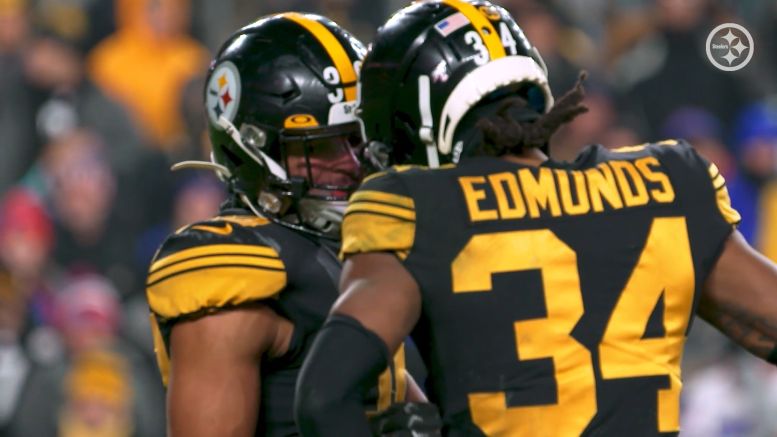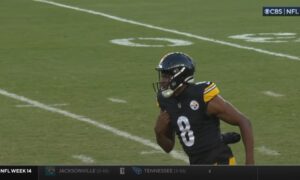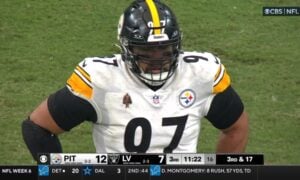It’s not often that a team gets outgained 318-168 in total yards, out possessed at a nearly 2:1 rate, all while allowing over 200 rushing yards and finds themselves able to come away with a win. Of course, your defense forcing four takeaways, holding the opposition to 1-4 in the red zone, and sacking quarterback Ryan Tannehill four times, all seemingly in key situations, goes a long way in producing such a result.
Ultimately, while the Steelers defense played great as a collective unit situationally, it was often the play of the teams starting safety tandem, Minkah Fitzpatrick and Terrell Edmunds, that prevented explosive plays and helped this team stay competitive into the fourth quarter. The two finished as the teams leading tackles, with Minkah collecting an eye popping 14, 12 of which were of the solo variety, with Edmunds chipping in 10 himself, seven of which were solo stops, including two key tackles resulting in losses.
All things considered, the stats don’t even tell the full story, as Minkah and Edmunds repeatedly had to make difficult open field stops at the second level, helping erase mistakes made at the second level and prevent explosive and double explosive runs. Minkah’s total tackle and solo numbers, respectively, both set new career single game highs, adding to his 102 total and 71 solos thus far on the season, a number that is sure to grow with three games still remaining. Thus, today we’ll be taking a deeper look into the film from the Steelers crucial Week 15 win against the Tennessee Titans, a game which was arguably the best the Steelers current starting safety tandem has produced over the past three seasons.
Film Analysis
Beginning last season, the Steelers coaching staff has committed increased effort towards varying Minkah Fitzpatrick’s usage in the defense, carving out more opportunities for him to play closer to the line of scrimmage. On the game’s first third down, Minkah, sitting in a two high shell, is tasked with “skying” down to the flat in a Cover 3 scheme. At the snap, Minkah rolls down patiently before settling, diagnosing RB screen, and triggering quickly to beat oncoming blockers and make the stop well short of the sticks, forcing an early punt.
On the Titans second series, this time operating as the deep ⅓ post safety in a Cover 3 scheme, Minkah is forced to contest an over route, as the linebackers were drawn in by play action. At the snap, Minkah patiently gives ground, staying on top of the post before keying Tannnehill’s release, flying out of his break with an efficient T-step, and arriving at the catch point to punish the tight end and eliminate any opportunity for yards after the catch.
Later in the drive, once again operating as the post safety in a single high set, Minkah triggers downhill in a hurry to fill a wide open cutback lane, preventing what could have easily been an explosive run. Once again, note how Minkah triggers downhill with no hesitation after diagnosing a run key, taking a proper angle and running his feet on contact to halt the powerful, 236 pound D’Onta Foreman in his tracks.
Later in the series, with the Titans facing third and short in the red zone, Minkah is once again operating as the post safety in a single high set. At the snap, Minkah stays patient before processing the read option keeper, working downhill while navigating past oncoming blockers, and beating Tannehill to the edge to force a cutback and make the stop just past the sticks. As you might remember, Minkah has made key plays in this exact scenario repeatedly throughout his Steelers career, most notably on third down stops against Kyler Murray in 2019 and Bengals legend Ryan Finley in Week 15 last season.
While some like to cite luck, there’s no denying that Minkah has routinely secured turnovers throughout his tenure in Pittsburgh by being in the right place at the right time, a testament to his natural instincts. Below, once again working as the post safety in a Cover 3 scheme, Minkah gives ground patiently as no receiver threatens his zone vertically, keeping himself in position to secure a loose ball that had been punched out by the field side flat defender, Arthur Maulet. The first turnover of the game gave the Steelers perfect field position to capitalize, although the offense would only come away with three points, the only points which they would score until the second half.
Late in the first half, this time operating as the post safety in a Cover 1 Nickel blitz, Minkah once again filled a vacant cutback lane, this time scraping from the backside to limit the run to under 10 yards. At the snap, Minkah stays patient before processing his run key, and scraping downhill past the Steelers linebackers to halt Ike Hilliard, who had galloped 10 yards untouched before Minkah arrived with a physical stick.
Just before half, with the Titans knocking on the redzone door and threatening to blow the game open with a touchdown, Minkah, working as the post safety in Cover 3, closes from his deep ⅓ zone to tackle Anthony Firkser short of the goal line. At the snap, Minkah gains depth to protect the seam before planting his feet at the goal line, keying Tannehill, and driving a ball curl to stop the tight end just past the five yard line, giving no chance for yards after the catch. Three plays later, a sack split between Cam Heyward and T.J. Watt would force the Titans to settle for a field goal, holding the deficit to just 10 points exiting a half where the team was dominated on both sides of the ball.
On the opening drive of the second half, with the Steelers in Cover 1, Terrell Edmunds made his first of two tackles for a loss on the day, diagnosing and blowing up a running back screen before it had any chance of developing. Working in man coverage on the tight end, Edmunds identifies Firskier has stayed in to block, allowing him to become a free player, diagnose RB screen, beat a pulling offensive lineman with a rip move, and stick the back behind the line of scrimmage.
Later in the series, with the Titans facing a third and long, the Steelers deploy a Cover 3 scheme, with Minkah Fitzpatrick “skying” down to assume flat responsibilities. At the snap, Minkah immediately triggers toward the flat before processing the RB draw, folding back inside and halting Jeremy McNichols well short of the sticks with a clean form tackle.
Later in the half, once again operating as the post safety in a single high set, Minkah was once again forced to make an open field stop on the imposing D’Onta Foreman, who had reached the second level untouched. At the snap, stays patient before processing the misdirection run, triggering downhill with a proper angle, maintaining inside leverage, and running his feet on contact to single-handedly prevent an explosive run.
Throughout his career, Terrell Edmunds has received plenty of criticism for his inability to produce splash plays and takeaways. While this play, in which Edmunds had two hands on the football but was unable to secure the pick, will do no favors to his reputation, he ultimately covered for Minkah and prevented an explosive play. Operating as a deep 1/2 safety in the Steelers Cover 2 zone, Edmunds pushes off the hashes identifying no threats in his zone and before flipping his hips to carry the post. Showing his range, Edmunds carries the post past the opposite numbers, staying on top and in position to high point the football and secure the downfield breakup. While the post should have been doubled, Minkah was caught with his eyes in the backfield, making Edmunds ability to work outside of the scheme on this play even more impressive.
On third down, the very next play, Edmunds once again blows up a screen pass, once again operating in man coverage, this time against a wide receiver screen. At the snap, Edmunds, tasked with man coverage on the tight end, quickly diagnoses the screen, closing downhill with inside leverage and sticking the receiver behind the line of scrimmage before he has a chance to turn downfield. While Edmunds lack of playmaking ability can turn some off to his game, his work in the box and in man coverage continually make him a valuable asset to any NFL defense.
On the next series, playing as an overhang defender to the weak side of an eight man box, Edmunds flows down the line unblocked, filling the open cutback lane and running his feet on contact to halt D’Onta Foreman short of ten yards. While these aren’t plays that will show up on the nightly highlights, Minkah and Edmunds continually held the Titans backs under ten yards on runs where they reached the second level untouched.
While Minkah exited the game without any splash plays in coverage, his awareness and instincts saved a potential touchdown on the play below, a blown assignment in Cover 1 man between Arthur Maulet and Ahkello Witherspoon. While it’s impossible to point out who’s in the wrong here as I can’t say for certain if the Steelers man scheme has leverage checks, both Witherspoon and Maulet drive a whip route to the flat, leaving nobody to account for a corner route out of the slot.
Nonetheless, Minkah, operating as the post safety, diagnoses the route combination immediately, traveling from opposite hash to numbers to work on top of the corner route, and erase the blown assignment. As Minkah makes a diving attempt at the overthrown ball, it’s not a stretch to say that he probably comes away with a pick if the pass had been delivered on target. Most fans treat this play like a routine incomplete pass, but you can count on one finger the NFL safeties who have the unique combination of range and instincts to make this play without hesitation.
I’ve talked about it in the past, but for all his struggles in the ball skills department, Terrell Edmunds man coverage abilities are criminally underrated and have long served as a tool for the team to be creative with its Nickel pressures. On the rep below, late in the game, Edmunds is in man coverage over the slot defender in the Cover 1 scheme, smartly opting to work out of catch man at six yards depth. At the snap, Edmunds stays patient, working laterally to protect his outside leverage before breaking efficiently on the out route, and arriving with a smooth form tackle to limit the catch to a gain of five yards, allowing no opportunity for yards after the catch.
Overall, the standout performances from the Steelers safety tandem provides mixed conclusions. On one hand, the Minkah and Edmunds ability to eliminate explosive plays routinely both in pass coverage, and more often than not, against the run, helped keep the Steelers in position to mount a fourth quarter comeback and keep their playoff hopes alive.
Nonetheless, any time your safeties combine for 24 tackles in a single game, it speaks volumes to the problems in your run defense, most notably at the second level, where Devin Bush, Joe Schobert, and Robert Spillane all struggled with physicality at the point of attack. All that being said, the Steelers run defense isn’t going to magically improve down the stretch this season, and with tough divisional games against the Browns and Ravens on the horizon, sitting third and fifth respectively in rushing yards per game, the Steelers will undoubtedly need to continue winning games in a non traditional fashion.
With playoff hopes still alive, the Steelers blueprint to winning will continue to revolve around limiting explosive plays, excelling in situational defense, and forcing timely turnovers to provide the Steelers lifeless offense with opportunities. With the Chiefs currently dealing with a Covid outbreak which has seen Travis Kelce, Tyreek Hill, Harrison Butker, Chris Jones, Charvarious Ward, and others placed on the list, Sunday’s game in Arrowhead could be an opportunity for the team to inch closer toward playoff contention. Regardless, the Steelers starting safety tandem will undoubtedly continue to play a pivotal role in the defense’s ability to carry this team toward contention down the stretch.








